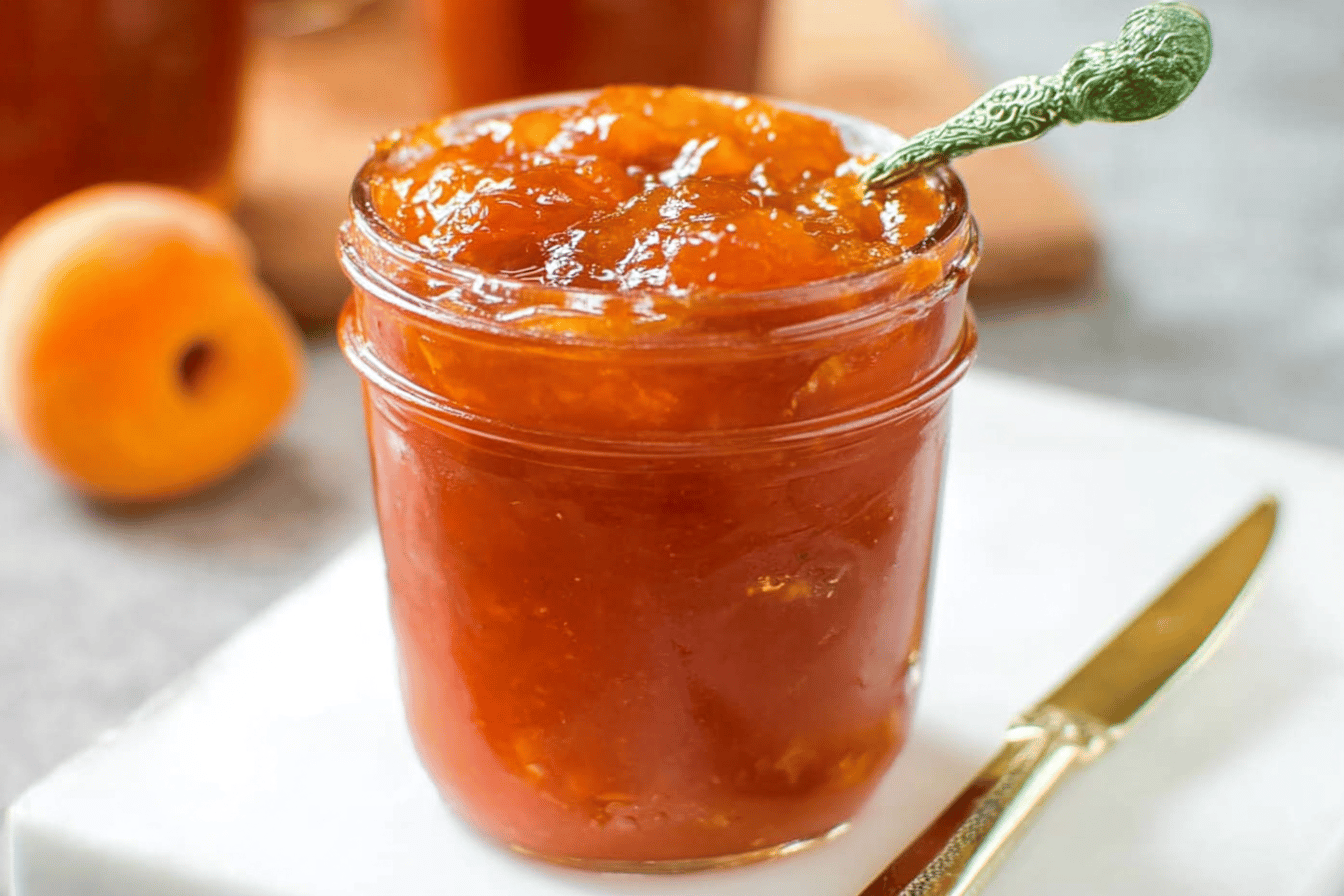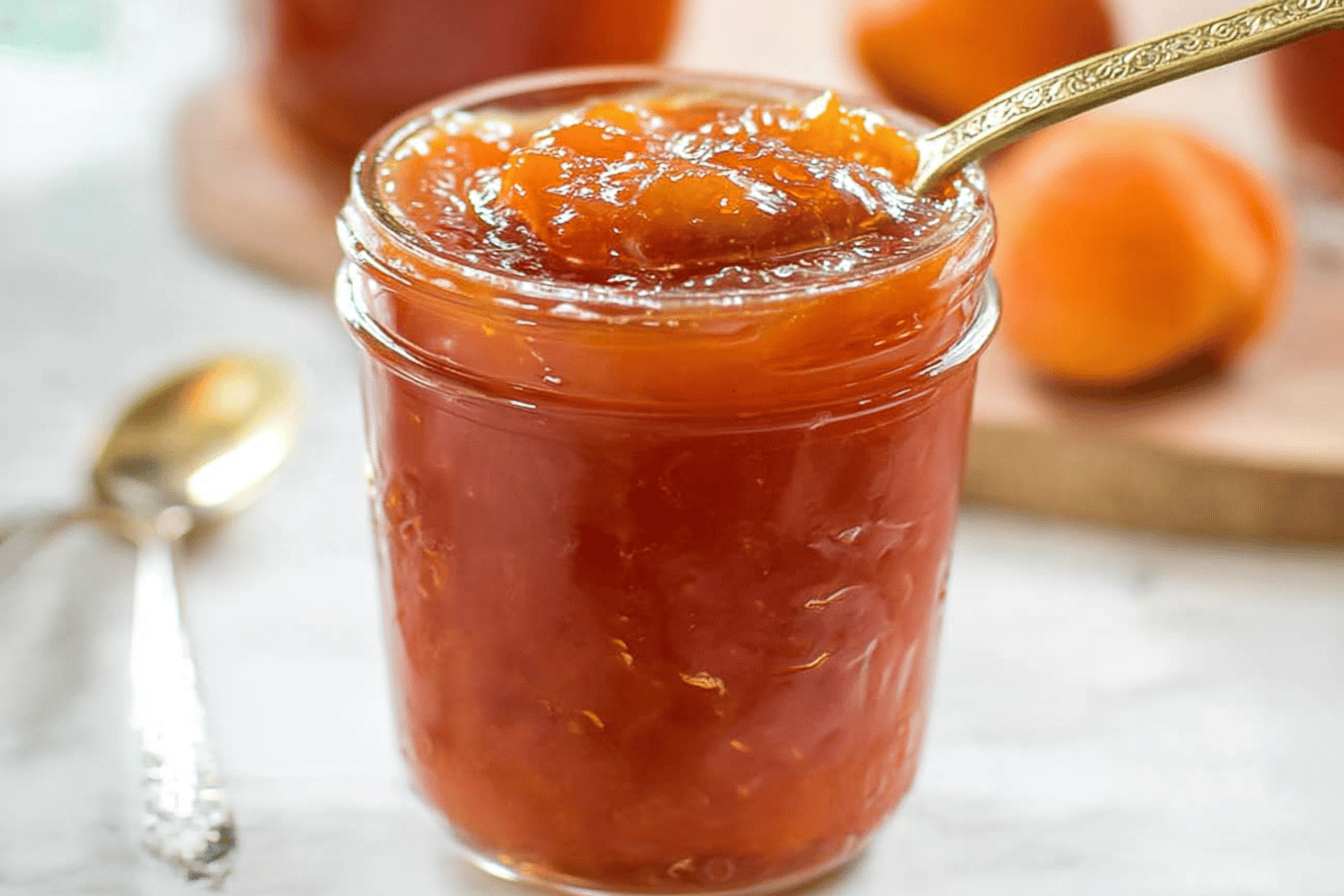Apricot Jam Recipe
Introduction
Apricot jam is a delightful addition to your breakfast table, spreading joy over toast, scones, and even savory dishes. This simple yet delicious recipe focuses on capturing the pure flavors of fresh apricots in a jar. It’s not only easy to make but also avoids unnecessary additives, ensuring you savor a homemade treat. Whether you enjoy it with a dollop of whipped cream or as a filling for desserts, apricot jam is a must-have staple.
Detailed Ingredients with Measures
To prepare this jam, you need only a handful of basic ingredients that work perfectly together:
Fresh Apricots:
You will need 2 pounds of ripe and sweet apricots, carefully washed, halved, and pitted. The fresh fruit is the star of this recipe, providing natural sweetness.
Granulated Sugar:
About 2 cups are required for this recipe. The sugar not only balances the tanginess of the apricots but also aids in preserving the jam.
Lemon Juice:
Use 2 to 3 tablespoons of freshly squeezed lemon juice as it adds a hint of brightness and ensures the jam reaches the perfect consistency.
Prep Time
While creating this wonderful apricot jam, you’ll appreciate its simplicity. The preparation time is approximately 15 minutes. From washing and cutting the apricots to mixing the ingredients, the process is straightforward and requires minimal effort.
Cook Time, Total Time, Yield
This recipe requires about 25-30 minutes of cook time as the apricots soften and meld with the sugar and lemon juice. The total time, including preparation, is around 45 minutes. The recipe yields approximately four small jars of jam, perfect for use throughout the week or sharing with loved ones.
With a little bit of time and a few ingredients, you’ll have a jar of apricot jam that not only tastes incredible but also brings a sense of accomplishment with every scoop. This recipe is truly an art of simplicity that transforms ripe fruit into a scrumptious condiment!
“`html
Detailed Directions and Instructions
Step 1: Prepare the apricots
Wash the apricots thoroughly under cool running water to remove any dirt or residue. Pat them dry with a clean kitchen towel or paper towel. Slice the apricots in half and remove the pits. If your apricots are particularly large, you can cut them into quarters.
Step 2: Measure the ingredients
Weigh the prepared apricots to ensure you have 1 kilogram (approximately 2.2 pounds). Then, measure out the sugar. The sugar quantity should match the weight of the apricots (1 kilogram). Also, prepare the juice of one fresh lemon.
Step 3: Combine ingredients in a large pot
Place the prepared apricots into a large, heavy-based pot or saucepan. Add the sugar and freshly squeezed lemon juice. Stir gently with a wooden spoon to combine all the ingredients.
Step 4: Allow the sugar to dissolve
Let the fruit and sugar mixture sit in the pot for approximately 1-2 hours. This will help the sugar dissolve and the fruit release its natural juices. Stir occasionally during this time to assist with the sugar dissolving process.
Step 5: Cook the apricot mixture
Place the pot on your stove over medium-high heat. Bring the mixture to a boil, stirring frequently to prevent it from sticking to the bottom of the pot. Once it reaches a boil, reduce the heat to medium and continue simmering.
Step 6: Monitor and skim off foam
During the cooking process, a foam may form on the surface. Use a spoon to skim this foam off and discard it. Stir occasionally to prevent the mixture from scorching.
Step 7: Test the jam for setting point
After 20-30 minutes of cooking, begin testing the jam for its setting point. To do this, place a small plate in the freezer for a few minutes. Drop a small spoonful of the jam onto the chilled plate and wait for a few seconds. Gently push the jam with your finger. If it wrinkles and holds its shape, it has reached its setting point. If not, continue cooking for a few more minutes and test again.
Step 8: Remove from heat
Once the jam reaches the setting point, remove the pot from the heat. Allow it to sit for 5 minutes to cool slightly. This will ensure the fruit is evenly distributed in the jam.
Step 9: Prepare and sterilize jars
During the cooking process, sterilize your jars and lids by boiling them in water for 10 minutes. Carefully remove them with tongs and place them upside down on a clean kitchen towel to dry. Ensure the jars are warm when filling to prevent them from cracking.
Step 10: Fill the jars
Using a clean ladle or wide-mouth funnel, carefully fill the sterilized jars with the warm jam. Leave about 1 centimeter (approximately ½ inch) of space at the top of each jar.
Step 11: Seal the jars
Wipe the rims of the jars with a clean, damp cloth to remove any spills or residue. Place the lids on top and seal tightly. If using jars with a screw-top lid, ensure they are fully tightened.
Step 12: Store or process the jars
Allow the jars to cool completely at room temperature. Once cooled, check that the lids have sealed properly. Store the jam in a cool, dark place. For extended storage, you may process the jars in a boiling water bath for 10 minutes.
Notes
Choose ripe but firm apricots
Select apricots that are ripe but not overly soft to ensure the best flavor and texture for your jam.
Use a heavy-based pot
A heavy-based pot helps to prevent the jam from burning during the cooking process by evenly distributing heat.
Adjust sweetness to taste
If you prefer a less sweet jam, you can reduce the sugar slightly. However, this may affect the final consistency and shelf life.
Lemon juice adds acidity
Lemon juice is essential as it not only enhances the flavor but also helps the jam to set by providing acidity.
Storing the jam
Once sealed, the jam can be stored in a cool, dark place for up to 12 months. After opening, keep it refrigerated and consume within 2-3 weeks.
Discard unsealed jars
If any jars fail to seal properly after cooling, store them in the refrigerator and consume the jam within a few weeks.
“`
Cook techniques
Preparing the Apricots
Ensure the apricots are ripe, fresh, and blemish-free. Wash them thoroughly, halve them, and remove the pits.
Cooking the Jam Mixture
Combine apricots and sugar, allowing the mixture to sit for some time so the sugar dissolves and extracts juice from the fruit.
Stirring and Skimming
Keep stirring the jam mixture regularly while cooking to prevent sticking or burning. Skim off any foam that forms on the surface for clarity.
Testing for Set Point
Use the cold plate method to test if the jam has reached its set point. Place a small portion on a chilled plate; if it wrinkles when pushed, it is ready.
Bottling the Jam
Pour hot jam into sterilized jars, leaving some headspace. Seal the jars tightly, ensuring they are clean around the rim.
FAQ
How do I sterilize jars for my jam?
You can sterilize jars by washing them in hot, soapy water, rinsing thoroughly, and placing them in a preheated oven at a low temperature until dry.
Can I use frozen apricots for this recipe?
Yes, frozen apricots can be used. Ensure they are fully thawed and drained of excess water before use.
How long will apricot jam last?
When properly sealed and stored in a cool, dark place, apricot jam can last for up to one year. Once opened, store it in the refrigerator and use it within a month.
Why is my jam too runny?
If the jam is runny, it may not have been cooked long enough to reach its set point. You can re-cook it to thicken.
Can I reduce the sugar in the recipe?
Reducing sugar may affect the texture and shelf life of the jam. It is recommended to follow the recipe for the best results.
What equipment do I need to make apricot jam?
You will need a heavy-based saucepan, a wooden spoon, sterilized jars, a funnel, a ladle, and a cold plate for testing set points.

Conclusion
In conclusion, apricot jam is a simple yet versatile recipe that allows you to enjoy the vibrant flavor of apricots year-round. Whether used as a breakfast spread, a baking ingredient, or part of a savory dish, its sweet and slightly tangy profile adds a delightful taste to many recipes. Homemade jam is always a rewarding experience, and this apricot jam brings both taste and satisfaction to your table.
More recipes suggestions and combination
Try it as a topping for yogurt or ice cream
Use apricot jam as a flavorful topping for plain yogurt or your favorite ice cream for a quick and delicious treat.
Incorporate it into baked goods
Add apricot jam to pastries, tarts, or as a filling for cookies for a burst of fruity sweetness.
Create a glaze for meats
Use apricot jam as a base for glazes when preparing pork, chicken, or lamb dishes to give them a subtle fruity flavor.
Perfect pairing with cheese
Pair apricot jam with a cheese platter for a sweet and tangy complement to both soft and hard cheeses.
Mix it into salad dressings
Combine apricot jam with vinegar, oil, and seasonings to create a unique and flavorful salad dressing.
Spread it over toast or scones
Enjoy the simple pleasure of apricot jam on freshly toasted bread, scones, or croissants for a delightful snack or breakfast option.







